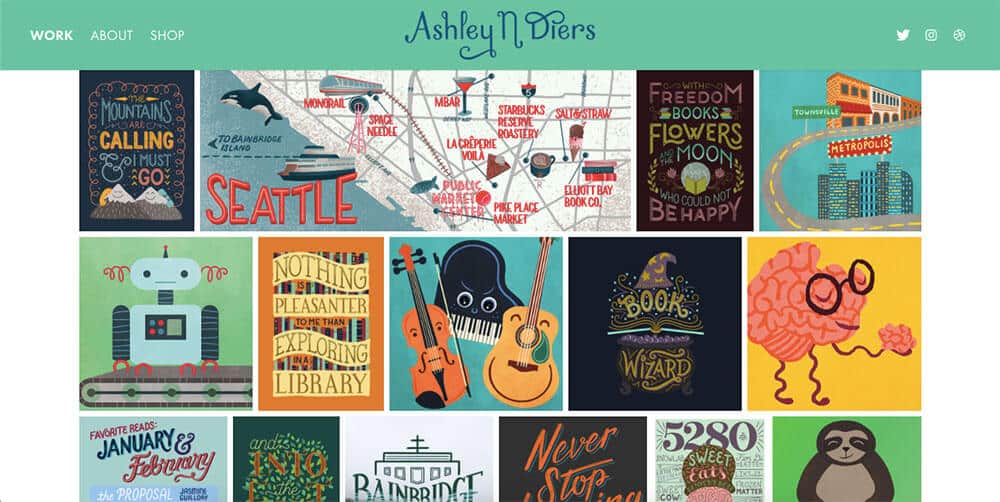One of my favorite things about college was how much free time I had. In comparison to high school, when every waking minute was filled with class, marching band, theater, clubs, or homework, college was refreshingly relaxed.
And it was with all this free time that I started exploring the world of freelance writing, website creation, and location independence. Eventually, that led me to the job I have now. And it all started with the side projects I pursued during college.
Since side projects have had such a positive impact on my life, I want to share how you can get started with them while you’re in college.
In this article, I’ll take a look at what side projects are, why they’re so important as a college student, and how you can start your own side project today.
What Are Side Projects?
Before we go any further, what is a side project? I define it as a personal project that you work on outside of your “day job.” Or, if you’re in college, something you work on outside of class.
A side project is distinct from a side hustle, in which the goal is to make extra money. While a side project could make you money, that’s not the point. Rather, a side project is something you work on because it’s fun or interesting.
A side project could be related to your job or major, but it differs because it’s entirely self-directed. It’s not something you do because a professor or boss requires it; you do it to satisfy your intellectual curiosity or gratify your creative impulses.
For instance, an app you build for your computer science class isn’t a side project. But a website you create in your free time certainly would be. An essay you write for your history class isn’t a side project. But the essays you publish on your blog would be.
You get the picture. But why bother taking time outside of class to work on even more projects? Aren’t you busy enough already?
4 Reasons to Start a Side Project in College
Wondering why you should start a side project? Here are four reasons to spend time on them while in college:
Show Employers You’re Independent and Motivated
Companies love to hire people who can solve their own problems and work on projects without someone breathing down their neck. Completing side projects demonstrates that you’re capable of both of these things.
Unlike classwork, which you’re required to complete, side projects take independent initiative. Demonstrating this initiative will set you apart from all the other job applicants with the same majors and internships.
Side Projects Fit in Your Schedule
While we encourage you to get an internship if you can, not everyone has the time. You may need to spend the summer working to help pay for college, or to take extra classes so you can graduate early. This can make it difficult to fit an internship into your schedule.
Side projects, on the other hand, are something you can work on whenever you have free time. You can squeeze them in between classes, extracurriculars, and part-time jobs.
Side Projects Let You Follow Your Interests
Unlike with internships, side projects let you work on anything that interests you.
If you’re interested in something obscure or niche, with no internships available, you can still gain interesting experience that you can talk about in a job interview.
Even if your side project isn’t the primary focus of your interview, it’s still great to have in your back pocket in case the interviewer asks, “Is there anything else you’d like us to know?”
Side Projects Let You Destress and Learn New Things
Finally, side projects have benefits beyond improving your employment prospects.
They offer a refreshing break from your major and typical coursework. And they’re a chance to express new ideas, learn new skills, or take creative risks without worrying about your grades.
Need help improving your grades? Here’s how to raise your GPA this semester.
How to Start Your Own Side Project Today
Now that you understand the benefits of side projects, let’s look at how you can start a project of your own.
But before I get into the details, an important disclaimer: you don’t have to know how to code to make a side project.
When researching this article, I was surprised to find how many guides to the topic focused on programming projects.
There’s nothing wrong with building apps or websites in your free time if that’s what interests you. But you can create a side project on any topic using almost any set of skills imaginable. Side projects are for everyone, no matter what your major!
With that out of the way, follow these steps to start your side project today:
1. Find an Idea That Interests You
The great thing about side projects is that there are no rules. Unlike the projects you work on for your classes, you can let your imagination run wild and pursue any interest you want.
I encourage you to work on whatever interests you most. Don’t worry if it has nothing to do with your major. That can actually be an advantage, an opportunity to broaden your skill set and have something distinctive to discuss with prospective employers.
To help you get started, here are some side project ideas:
- Write a novel, poems, or short stories
- Start a blog
- Research a topic (or person) that interests you and write a paper about it
- Build a personal website
- Take a series of photos of a particular subject
- Create an app
- Learn to play a musical instrument
- Start a YouTube channel
- Research and write about your family history
- Learn a new language
But don’t let this list constrain you. It’s just a starting point, something to get the ideas flowing.
2. Make a Plan
Starting a new project is always exciting. But if you don’t create some kind of plan, the project may sputter out the moment it becomes difficult or you get distracted with something else.
While there’s nothing wrong with shifting to new projects as your interests change, there’s also value in finishing a project.
Therefore, I encourage you to create at least a rough plan for how you’ll work on (and ultimately complete) your project. Set a series of ongoing goals so you know you’re making progress. For instance, you could set a goal to take 5 photos a week or work on your app for an hour each day.
In reality, of course, your project may not go according to plan. You’ll likely discover new things or encounter new challenges along the way that cause you to change direction. There’s nothing wrong with this; it’s part of the creative process.
3. Work on Your Project Regularly
Since this is a “side” project, the biggest challenge will be finding time to work on it regularly amidst all your other obligations. It’s easy to push your project aside when you have homework to finish, a club meeting to attend, or even a friend asking if you want to play “just one more round” of Super Smash Bros.
To stay diligent on your project, schedule time for it. Put a block of time on your calendar for “side project work.” Don’t schedule anything else during that time, just as you wouldn’t schedule something else during a class.
I used this strategy extensively when I started my blog. I had a block of time on my calendar each Monday morning to “write for my blog,” and another on Tuesday afternoon to “edit and publish articles.”
I scheduled these time blocks to fit between my classes, homework, and other activities. And with time, I was amazed at the body of work I managed to produce.
Give it a try; you’ll be surprised what’s possible.
To make progress on your side project, you need to make it a habit. Learn how to build habits that stick with our free course:
Building habits isn’t just about discipline; there are real-world steps you can take to set yourself up for success! In this course, you'll learn how to set realistic goals, handle failure without giving up, and get going on the habits you want in your life.
4. Continue Until It’s Done (or You Get Bored)
Deciding when a project is “done” is one of the great challenges of any work you do in your free time.
To start, there are some projects without a clear end. A blog or YouTube channel, for instance, could theoretically go on forever. And even with projects that seem more finite, such as building an app, there are always updates you can make or features you can add.
Therefore, you’ll need to use your discretion to decide when the project is “done.” Some projects naturally fizzle out or end due to a lack of time or a loss of interest. Other times, you’ll have to deliberately say, “I’m done with this, it’s time to move on to something else.”
But when the time does come to end a project, be sure to save some record of it. If it’s an analog project, take some photos of it. If it’s a digital project, create backups (we recommend Backblaze for easy, automatic backups).
You never know when material from an old project could come in handy for a future one. Plus, creating a record makes it easy to show off your project to potential employers, interested friends, or even future collaborators. Which brings me to one more piece of advice….
Bonus Tip: Collaborate (You Don’t Have to Work Solo)
Many discussions of side projects assume that the project is a solo endeavor.
However, that doesn’t have to be the case. There’s immense value in collaborating on a side project with someone else. You can benefit from a complementary skill set, brainstorm new ideas, and get practice working with others (a skill that’s valuable in any job, as well as life in general).
And unlike the torturous group projects you have to work on for class, you have the freedom to choose the person (or persons) you work with.
If you’re trying to find a collaborator, start around campus. You could get old school and post a paper ad on bulletin boards in the student center or your dorm (just make sure to get permission if required).
Campus social media groups can also be a valuable resource, or you can even strike up a conversation with someone in one of your classes who seems like a good potential collaborator.
Finally, ask your friends if they know anyone interested in collaborating. You never know who they might introduce you to.
Side Project Examples from the College Info Geek Team
To close this article, I want to leave you with some inspiration. Below, I’ve put together a list of some side projects from the College Info Geek team. I hope these give you a glimpse of what’s possible and encourage you to start your own side project:
1. Nature Photography (Martin Boehme)

You may know Martin as the co-host of the CIG Podcast (and, more recently, The Inforium). And you’re also looking at his handiwork right now — he’s the developer wizard who keeps this site running.
Outside his work for College Info Geek, however, Martin is also an accomplished photographer. You can check out his work here. And if you’re interested in hanging one of his photos on your wall, have a look at his online shop.
Want to learn how to take your own photos? Check out Martin’s guide.
2. Music Production and Songwriting (Thomas Frank)
Thomas is the founder of this website and the creator of a popular YouTube channel about productivity and study advice (among many other things).
But in his free time, he’s also an avid musician and music producer. Check out his music channel!
3. Tech Review Videos (Tony Santos)
Tony is the video editor behind the Thomas Frank YouTube channel, and you’ve likely seen his work if you spend any amount of time on this site.
But did you know he also has his own YouTube channel where he reviews tech products? Give his videos a watch.
4. Illustrations and Hand Lettering (Ashley Diers)

Ashley creates all the illustrations you see for our podcast episodes, as well as lots of other graphics around this website.
But she also creates illustrations and hand-lettered works based on travel, literature, and much more. Check out her work here.
5. This Website (Thomas Frank, later many others)

Finally, I want to mention that this website started as a side project in Thomas’ dorm back in 2010.
While it’s since grown into a full-time business with a team of several people, it all started with a dude typing his thoughts into a text editor and publishing them to the world. (Here’s the full story of how College Info Geek started).
Now, there’s no guarantee that your side project will turn into a full-time gig (assuming you even want that). But it’s certainly possible.
Get Started on Your Side Project
Side projects are an enriching, worthwhile pursuit. They can help you stand out when applying for a job, teach you new skills, and provide a creative outlet beyond your coursework.
Whatever project you’re considering, don’t delay! Start it now. You never know where it might lead.
Image Credits: watercolor set



